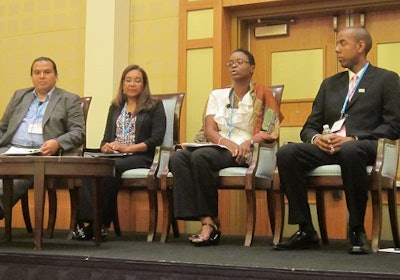 From left to right, Scott Pinkham of the University of Washington; Dr. Bevlee Watford of Virginia Tech; Dr. Felicia Benton-Johnson of Georgia Tech; and Christopher Smith of NACME discuss long-term study Tuesday. (Photo by Ronald Roach)
From left to right, Scott Pinkham of the University of Washington; Dr. Bevlee Watford of Virginia Tech; Dr. Felicia Benton-Johnson of Georgia Tech; and Christopher Smith of NACME discuss long-term study Tuesday. (Photo by Ronald Roach)WASHINGTON — The first long-term study tracking underrepresented minority students at institutions participating in a national engineering diversity consortium found an 84.1 percent retention rate among those students in the consortium’s scholarship program.
This finding has come as good news to the National Action Council for Minorities in Engineering (NACME), Inc. whose release of its “NACME Scholars Retention and Graduation Report Cohort Years 2004 — Summer 2012” study was one of the highlights of the group’s national meeting on Tuesday in Washington.
Christopher Smith, the director of research and evaluation at NACME, Inc., told roughly 100 meeting attendees that, while additional research is needed to produce six-year graduation rates of NACME Scholars, the newly-released research represents promise for the organization’s goal that its scholars achieve an 80 percent graduation rate. He noted that the study found overall that the six-year graduation rate of underrepresented minorities (URM) is 39.3 percent at 23 NACME Partner Institutions, while the rate for non-underrepresented minority students is 60.3 percent.
“The numbers are a bit more encouraging for the NACME Scholar. … We see retention and graduation rate for NACME Scholars — [meaning] those who graduated and those who are still enrolled — is 84.1 percent of our NACME Scholars, and this is across 29 schools,” Smith said.
“We’re very encouraged by this, and the goal for all of our NACME Scholars at each of our partnering institutions is to eventually graduate 80 percent of them. So this shows that this is certainly possible,” he noted. “And again, going forward, we’re going to calculate the six-year graduation rate for these scholars … so that’s the next part of our research.”
Smith told Diverse that with the launch of their Block Grant Program in 2003, NACME began collecting long-term retention and graduation data, which has made the recent study possible. Under the Block Grant Program, participating schools receive a five-year grant whose proceeds are distributed directly to students as scholarships. Scholarship students are required to have a minimum grade point average of 2.5., according to NACME.
“One of the goals of the NACME Block Grant is for institutions who become block grant partners to close the gap between minorities and non-minorities in the colleges of engineering. So we’re not just looking at the NACME Scholars, but we want to see the [retention and graduation] gap close between all URMs in the colleges of engineering and the non-URMs,” Smith said.
Since 1974, NACME has advanced a national effort to increase the number of African-American, American Indian and Latino women and men in science, technology, engineering and mathematics (STEM) education and careers. Over the years, with funding from corporate, foundation and individual donors, NACME has supported roughly 24,000 students with more than $124 million in scholarships and other support. NACME provides scholarship support for more than 1,300 underrepresented minority engineering students that attend college in a national network of 50 NACME Partner Universities.
This week, NACME is convening its Continuum, National Symposium and Board of Directors meetings, which continue through Thursday. The Continuum meeting, which concluded Tuesday, brought together deans and other academic administrators along with teachers and administrators from NACME’s K-12 programs. The Continuum meeting highlights best practices and NACME partnerships for attendees.
The National Symposium meeting, which resumes today, focuses on public policy and lobbying federal officials. “Basically, what we’re trying to focus on is the translation of research to policy to action,” said Dr. Irving P. McPhail, NACME president and CEO.
“We’re trying to surface key research issues that ought to drive policy changes that will result in more of our kids becoming engineers,” he noted.
Despite the federal government shutdown, McPhail said NACME is proceeding with panel discussions it had planned to convene on Capitol Hill. Rather than on the Hill, the panels will be held at the hotel at which NACME has convened the Continuum and National Symposium meetings.
“We’ve got a very active public policy engineering agenda; I’ve been spending two days a month in D.C. up on the Hill with staffers … trying to get the word out about NACME, about NACME strategy, and about the need for support — things we need to do to really produce more underrepresented minority engineers,” he said.



















